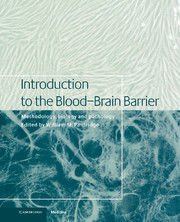Book contents
- Frontmatter
- Contents
- List of contributors
- 1 Blood–brain barrier methodology and biology
- Part I Methodology
- Part II Transport biology
- Part III General aspects of CNS transport
- Part IV Signal transduction/biochemical aspects
- Part V Pathophysiology in disease states
- 41 Cerebral amyloid angiopathy
- 42 Brain microvasculature in multiple sclerosis
- 43 Hemostasis and the blood–brain barrier
- 44 Microvascular pathology in cerebrovascular ischemia
- 45 HIV infection and the blood–brain barrier
- 46 Hypertension
- 47 The blood-brain barrier in brain tumours
- 48 The pathophysiology of blood–brain barrier dysfunction due to traumatic brain injury
- 49 Cerebral malaria and the brain microvasculature
- 50 Molecular basis of tissue tropism of bacterial meningitis
- Index
48 - The pathophysiology of blood–brain barrier dysfunction due to traumatic brain injury
from Part V - Pathophysiology in disease states
Published online by Cambridge University Press: 10 December 2009
- Frontmatter
- Contents
- List of contributors
- 1 Blood–brain barrier methodology and biology
- Part I Methodology
- Part II Transport biology
- Part III General aspects of CNS transport
- Part IV Signal transduction/biochemical aspects
- Part V Pathophysiology in disease states
- 41 Cerebral amyloid angiopathy
- 42 Brain microvasculature in multiple sclerosis
- 43 Hemostasis and the blood–brain barrier
- 44 Microvascular pathology in cerebrovascular ischemia
- 45 HIV infection and the blood–brain barrier
- 46 Hypertension
- 47 The blood-brain barrier in brain tumours
- 48 The pathophysiology of blood–brain barrier dysfunction due to traumatic brain injury
- 49 Cerebral malaria and the brain microvasculature
- 50 Molecular basis of tissue tropism of bacterial meningitis
- Index
Summary
Introduction
Over the past 20 years, our appreciation of the pathobiology of traumatic brain injury has increased significantly. Prior to that time, it was unknown whether the morbidity associated with traumatic brain injury was a direct result of traumatically induced vascular failure or alternatively the direct disruption of brain parenchyma and its neural connections. We now appreciate that the traumatic episode involves a progression and possible interaction of brain parenchymal and vascular changes across the full spectrum of traumatic brain injury, ranging from mild through severe. In relation to the brain parenchyma, it is now understood that brain injuries of varying severity are capable of releasing a surge of neurotransmitters that participate in abnormal agonist–receptor interactions causing altered postsynaptic signal transduction correlated with behavioral abnormalities (Hayes et al., 1988, 1992; Mclntosh et al., 1989a; Katayama et al., 1990). Importantly, these same neuroexcitatory surges have also been linked to post-traumatic glucose hypermetabolism (Hayes et al., 1984; Yoshino et al., 1991; Hovda, 1996) that can have catastrophic consequences if an uncoupling of flow and metabolism occurs. In addition to these neuroexcitatory-mediated changes, it is known that the shear and tensile forces of injury also stretch axons throughout the neuraxis, resulting in focal alterations of axoplasmic transport that lead to axonal swelling and detachment (Povlishock et al., 1983; Povlishock, 1992; Povlishock and Jenkins, 1995).
- Type
- Chapter
- Information
- Introduction to the Blood-Brain BarrierMethodology, Biology and Pathology, pp. 441 - 453Publisher: Cambridge University PressPrint publication year: 1998
- 4
- Cited by



